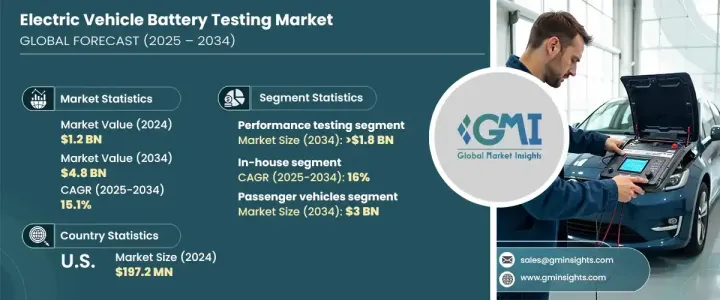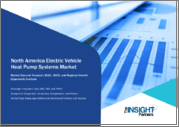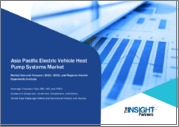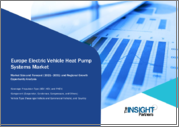
|
시장보고서
상품코드
1698294
전기자동차 배터리 시험 시장 기회, 성장 촉진요인, 산업 동향 분석, 예측(2025-2034년)Electric Vehicle Battery Testing Market Opportunity, Growth Drivers, Industry Trend Analysis, and Forecast 2025-2034 |
||||||
세계의 전기자동차 배터리 시험 시장은 2024년 12억 달러로 평가되었으며, 전기차의 급속한 보급과 이 분야에 대한 정부 투자 증가로 2025년부터 2034년까지 연평균 복합 성장률(CAGR) 15.1%를 나타낼 것으로 예측됩니다.
세계 각국의 정부는 세금 공제, 리베이트, 보조금 등의 재정적 인센티브를 제공하고 전기자동차(EV)를 보다 많은 사람들이 이용하기 쉽도록 하고 있습니다.

자동차 및 배터리 제조업체는 진화하는 업계 표준 및 규제 요구 사항을 충족하기 위해 배터리 성능, 수명 및 안전성 향상에 주력하고 있습니다. 고급 시험 방법론을 활용한 예측 분석과 실시간 모니터링 등 첨단 시험 방법이 배터리 시험 프레임워크에 통합되어 정확성과 신뢰성이 향상되고 있습니다.
| 시장 범위 | |
|---|---|
| 시작 연도 | 2024년 |
| 예측 연도 | 2025-2034년 |
| 시작 금액 | 12억 달러 |
| 예측 금액 | 48억 달러 |
| CAGR | 15.1% |
전기자동차 배터리 시험 시장은 시험 유형별로 성능 시험, 안전성 시험, 라이프 사이클 시험로 구분됩니다. 전지의 안전성에 관한 규제가 점점 엄격해지는 가운데, 제조업체는 열안정성, 내단락성, 과충전 방지 등의 중요한 평가에 중점을 두게 되어 있습니다.
시장 세분화의 또 다른 중요한 부분은 소싱이며, 사내 시험과 아웃소싱으로 분류됩니다. 이 프로그램은 제품의 신뢰성을 높일 뿐만 아니라 제조업체가 성능 문제를 신속하게 파악하고 해결할 수 있도록 합니다.
미국의 전기자동차 배터리 시험 시장은 전기자동차와 배터리 생산 증가에 힘입어 2024년 1억 9,720만 달러를 창출했습니다. 미국 정부가 에너지 자립을 추진하고 국내 EV 제조에 대한 지원을 강화하는 가운데 신뢰할 수 있는 배터리 시험 솔루션 수요가 급증할 것으로 예상됩니다. 연구개발에 대한 투자가 증가하고 배터리 기술의 진보도 함께 미국 시장은 세계의 전기자동차 배터리 시험 상황을 형성하는데 있어서 매우 중요한 역할을 하게 될 것으로 보입니다. 자동차 및 배터리 제조업체가 혁신을 우선시하는 동안 종합적인 시험 프레임워크의 필요성이 계속해서 시장 확대를 촉진하고 EV 배터리가 최고 수준의 성능과 안전성을 충족할 수 있도록 합니다.
목차
제1장 조사 방법과 조사 범위
- 조사 디자인
- 조사 접근
- 데이터 수집 방법
- 기본 추정과 계산
- 기준연도의 산출
- 시장추계의 주요 동향
- 예측 모델
- 1차 조사와 검증
- 1차 정보
- 데이터 마이닝 소스
- 시장 범위와 정의
제2장 주요 요약
제3장 업계 인사이트
- 생태계 분석
- 장비 제공업체
- 서비스 제공업체
- 기술 제공업체
- 최종 고객
- 공급업체의 상황
- 이익률 분석
- 기술 혁신의 상황
- 특허 분석
- 주요 뉴스 및 이니셔티브
- 규제 상황
- 이용 사례
- 영향요인
- 성장 촉진요인
- 급속한 EV 보급과 인프라의 확대
- 정부의 강력한 규제와 인센티브
- 기술 진보와 R&D 투자
- 지속가능성과 환경목표의 중시
- 업계의 잠재적 위험 및 과제
- 복잡한 시험 프로세스
- 높은 운영 비용
- 성장 촉진요인
- 성장 가능성 분석
- Porter's Five Forces 분석
- PESTEL 분석
제4장 경쟁 구도
- 서론
- 기업 점유율 분석
- 경쟁 포지셔닝 매트릭스
- 전략 전망 매트릭스
제5장 시장 추계·예측 : 시험별(2021-2034년)
- 주요 동향
- 성능 시험
- 안전성 시험
- 수명 주기 시험
- 기타
제6장 시장 추계·예측 :소싱별(2021-2034년)
- 주요 동향
- 인하우스
- 아웃소싱
제7장 시장 추계·예측 : 차량별(2021-2034년)
- 주요 동향
- 승용차
- 해치백
- 세단
- SUV차
- 상용차
- 소형 상용차(LCV)
- 대형 상용차(HCV)
제8장 시장 추계·예측 : 추진력별(2021-2034년)
- 주요 동향
- 배터리 전기자동차(BEV)
- 플러그인 하이브리드 자동차(PHEV)
- 하이브리드 전기자동차(HEV)
제9장 시장 추계·예측 : 최종 용도별(2021-2034년)
- 주요 동향
- 자동차 OEM
- 배터리 제조업체
- 연구 및 개발기관
- 타사 시험 서비스 제공업체
제10장 시장 추계·예측 : 지역별(2021-2034년)
- 북미
- 미국
- 캐나다
- 유럽
- 영국
- 독일
- 프랑스
- 이탈리아
- 스페인
- 러시아
- 북유럽
- 아시아태평양
- 중국
- 인도
- 일본
- 호주
- 한국
- 동남아시아
- 라틴아메리카
- 브라질
- 멕시코
- 아르헨티나
- 중동 및 아프리카
- UAE
- 남아프리카
- 사우디아라비아
제11장 기업 프로파일
- ALS
- Applus
- Arbin
- AVILOO
- AVL
- Bureau Veritas
- DEKRA
- DNV
- Element
- Eurofins
- Instron
- Intertek
- Nemko
- NTS
- SGS
- Tektronix
- TUV Nord
- TUV SUD
- UL Solutions
The Global Electric Vehicle Battery Testing Market, valued at USD 1.2 billion in 2024, is projected to expand at a CAGR of 15.1% between 2025 and 2034, driven by the rapid adoption of electric vehicles and increasing government investments in the sector. Governments worldwide are offering financial incentives, such as tax credits, rebates, and grants, making EVs more accessible to a broader audience. As more consumers transition to electric mobility, the demand for high-performance, safe, and durable batteries is rising, fueling the need for comprehensive battery testing services.

Automakers and battery manufacturers are focusing on enhancing battery performance, lifespan, and safety to meet evolving industry standards and regulatory requirements. Battery testing ensures that EV batteries maintain optimal efficiency under varying conditions while complying with stringent safety guidelines. Advanced testing methodologies, including AI-driven predictive analytics and real-time monitoring, are being integrated into battery testing frameworks to improve accuracy and reliability. The expansion of EV production, particularly in North America, Europe, and Asia-Pacific, further underscores the growing necessity for robust battery testing protocols.
| Market Scope | |
|---|---|
| Start Year | 2024 |
| Forecast Year | 2025-2034 |
| Start Value | $1.2 Billion |
| Forecast Value | $4.8 Billion |
| CAGR | 15.1% |
The EV battery testing market is segmented by testing type into performance testing, safety testing, and lifecycle testing. The performance testing segment held a 35% market share in 2024 as manufacturers prioritize battery efficiency and endurance. However, safety testing is expected to witness substantial growth, generating USD 1.8 billion by 2034. With increasingly stringent regulations governing battery safety, manufacturers are intensifying their focus on critical assessments such as thermal stability, short-circuit resistance, and overcharging prevention. Ensuring that batteries meet the highest safety standards is a top priority, particularly as EV adoption surges and consumer expectations for reliability and security grow.
Another key segmentation of the market is sourcing, categorized into in-house testing and outsourcing. In 2024, the in-house testing segment accounted for 58% of the market share. Companies investing in in-house testing benefit from greater control over testing protocols, allowing them to tailor programs to specific battery designs. This approach not only enhances product reliability but also enables manufacturers to identify and resolve performance issues promptly. By refining testing methodologies internally, companies can adapt to evolving technological advancements and regulatory changes with greater agility.
The U.S. EV battery testing market generated USD 197.2 million in 2024, propelled by the increasing production of electric vehicles and batteries. As the U.S. government pushes for energy independence and strengthens support for domestic EV manufacturing, the demand for reliable battery testing solutions is expected to surge. With rising investments in research and development, coupled with advancements in battery technology, the U.S. market is set to play a pivotal role in shaping the global EV battery testing landscape. As automakers and battery manufacturers prioritize innovation, the need for comprehensive testing frameworks will continue to drive market expansion, ensuring that EV batteries meet the highest standards of performance and safety.
Table of Contents
Chapter 1 Methodology & Scope
- 1.1 Research design
- 1.1.1 Research approach
- 1.1.2 Data collection methods
- 1.2 Base estimates & calculations
- 1.2.1 Base year calculation
- 1.2.2 Key trends for market estimation
- 1.3 Forecast model
- 1.4 Primary research and validation
- 1.4.1 Primary sources
- 1.4.2 Data mining sources
- 1.5 Market scope & definition
Chapter 2 Executive Summary
- 2.1 Industry synopsis, 2021 - 2034
Chapter 3 Industry Insights
- 3.1 Industry ecosystem analysis
- 3.1.1 Equipment providers
- 3.1.2 Service providers
- 3.1.3 Technology providers
- 3.1.4 End customers
- 3.2 Supplier landscape
- 3.3 Profit margin analysis
- 3.4 Technology & innovation landscape
- 3.5 Patent analysis
- 3.6 Key news & initiatives
- 3.7 Regulatory landscape
- 3.8 Use cases
- 3.9 Impact forces
- 3.9.1 Growth drivers
- 3.9.1.1 Rapid EV adoption and infrastructure expansion
- 3.9.1.2 Strong government regulations and incentives
- 3.9.1.3 Technological advancements and R&D investments
- 3.9.1.4 Focus on sustainability and environmental goals
- 3.9.2 Industry pitfalls & challenges
- 3.9.2.1 Complex Testing Processes
- 3.9.2.2 High operational costs
- 3.9.1 Growth drivers
- 3.10 Growth potential analysis
- 3.11 Porter's analysis
- 3.12 PESTEL analysis
Chapter 4 Competitive Landscape, 2024
- 4.1 Introduction
- 4.2 Company market share analysis
- 4.3 Competitive positioning matrix
- 4.4 Strategic outlook matrix
Chapter 5 Market Estimates & Forecast, By Testing, 2021 - 2034 ($Bn)
- 5.1 Key trends
- 5.2 Performance testing
- 5.3 Safety testing
- 5.4 Lifecycle testing
- 5.5 Others
Chapter 6 Market Estimates & Forecast, By Sourcing, 2021 - 2034 ($Bn)
- 6.1 Key trends
- 6.2 In-house
- 6.3 Outsourcing
Chapter 7 Market Estimates & Forecast, By Vehicle, 2021 - 2034 ($Bn)
- 7.1 Key trends
- 7.2 Passenger vehicles
- 7.2.1 Hatchback
- 7.2.2 Sedan
- 7.2.3 SUV
- 7.3 Commercial vehicles
- 7.3.1 Light Commercial Vehicles (LCV)
- 7.3.2 Heavy Commercial Vehicles (HCV)
Chapter 8 Market Estimates & Forecast, By Propulsion, 2021 - 2034 ($Bn)
- 8.1 Key trends
- 8.2 Battery Electric Vehicles (BEV)
- 8.3 Plug-in Hybrid Electric Vehicles (PHEV)
- 8.4 Hybrid Electric Vehicles (HEV)
Chapter 9 Market Estimates & Forecast, By End Use, 2021 - 2034 ($Bn)
- 9.1 Key trends
- 9.2 Automotive OEMs
- 9.3 Battery manufacturers
- 9.4 Research and development institutes
- 9.5 Third-party testing service providers
Chapter 10 Market Estimates & Forecast, By Region, 2021 - 2034 ($Bn)
- 10.1 North America
- 10.1.1 U.S.
- 10.1.2 Canada
- 10.2 Europe
- 10.2.1 UK
- 10.2.2 Germany
- 10.2.3 France
- 10.2.4 Italy
- 10.2.5 Spain
- 10.2.6 Russia
- 10.2.7 Nordics
- 10.3 Asia Pacific
- 10.3.1 China
- 10.3.2 India
- 10.3.3 Japan
- 10.3.4 Australia
- 10.3.5 South Korea
- 10.3.6 Southeast Asia
- 10.4 Latin America
- 10.4.1 Brazil
- 10.4.2 Mexico
- 10.4.3 Argentina
- 10.5 MEA
- 10.5.1 UAE
- 10.5.2 South Africa
- 10.5.3 Saudi Arabia
Chapter 11 Company Profiles
- 11.1 ALS
- 11.2 Applus+
- 11.3 Arbin
- 11.4 AVILOO
- 11.5 AVL
- 11.6 Bureau Veritas
- 11.7 DEKRA
- 11.8 DNV
- 11.9 Element
- 11.10 Eurofins
- 11.11 Instron
- 11.12 Intertek
- 11.13 Nemko
- 11.14 NTS
- 11.15 SGS
- 11.16 Tektronix
- 11.17 TUV Nord
- 11.18 TUV SUD
- 11.19 UL Solutions



















